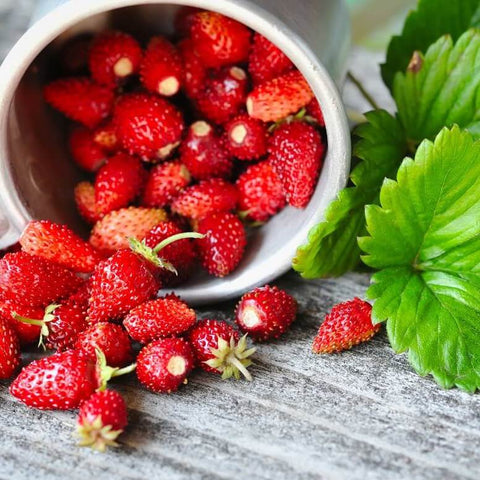

Hortinova
ALPINE - Open Pollinated Strawberry Seeds
Fragaria vesca
- Early and high-yielding European heirloom variety.
- Remontant strawberry variety that does not produce runners.
- Compact plant with spherical bush habit that can reach 18 cm in height.
- Produces clusters of large white flowers followed by intensely delicious red berries, naturally everbearing from June to late fall.
- Unpretentious, productive plant, and surprisingly decorative. Can be grown on the balcony.
- Can be grown in the open field with the use of temporary low tunnels if necessary.
- Strong tolerance to frequent changes in weather.
Start the seeds indoors 10 to 12 weeks before your average last frost date. This gives the plants time to grow strong indoors and extends each plant’s growing season. Fill seed trays or small pots with a well-draining seed-starting mix. Moisten the soil, then sow the seeds on the surface and gently press them into the soil. Strawberry seeds require light to for the best germination results so do not bury the seeds with soil. Gently spray the soil with water and be careful not to dislodge the seeds from the soil.
Cover the tray with a clear plastic lid or plastic wrap to create a mini-greenhouse effect. Place the seed tray in a warm location with indirect sunlight, such as a windowsill or under a grow light. The ideal germination temperature is around 65-75°F (18-24°C). Keep the soil consistently moist but not waterlogged. Seeds require consistent moisture to germinate. Strawberry seeds typically take between 1-2 weeks to sprout.
TRANSPLANT: Once the seedlings have developed their first true leaves (usually after 4-6 weeks), they are ready for transplanting however only transplant outdoors after the last frost date in your area. Gradually accustom plants to outside conditions (avoid frosts), before planting out in May-June. Choose a location in your garden with fertile well-draining soil, full sun with partial shade. Raised beds are a particularly good option for strawberry plants. Soil pH should be slightly acidic between 5.5 and 7.0. Take care not to damage the roots while removing the seedlings from the see tray. Dig holes in the prepared garden bed, spaced about 12-18 inches apart. Plant the seedlings at the same depth they were in the seed tray and water them gently after transplanting.
WATER: Moisture is incredibly important to strawberries due to their shallow roots. Water your strawberry plants at the base, avoiding wetting the foliage. Keep the soil consistently moist but not waterlogged throughout the growing season. Consider using a drip irrigation system to provide consistent moisture without wetting the leaves, which can lead to disease. Water adequately, about one inch per square foot per week. Strawberry plants need a lot of water when the flowers are developing and again in the late summer, when the plants are fully mature and gearing up for winter dormancy.
PROTECT: Mulch around the base of the plants with straw or wood chips to retain soil moisture and suppress weed growth. Regularly inspect your plants for signs of pests such as aphids, slugs, and snails. If you notice any infestations, take appropriate measures to control them. This could include using organic insecticides such as neem seed oil, introducing beneficial insects, or physically removing the pests. Maintain good air circulation by spacing plants properly and removing any dead or diseased leaves.
FEED: Use a balanced, granular slow-release fertilizer at the beginning of the season, or a liquid option as much as once a week.
PRUNE: Regularly remove any dead or yellowing leaves to promote better airflow and reduce the risk of disease. For the first year of your strawberry plants’ life, they need to focus energy on establishing good roots. The rule of thumb is to clip off the first round of blossoms in June. This should result in a stronger plant and plumper strawberries in the next crop. Alpine strawberries are perennial plants, so they will continue to produce fruit for multiple years if well-maintained.
The alpine strawberries will start producing fruits in early summer, and the harvest season can last until late fall. The fruits will be about the size of a fingernail. Harvest the ripe berries when they are fully red and have a sweet aroma. Gently pick the strawberries to avoid bruising. Decaying fruits may invite pests and disease, so try to stay on top of harvesting them.
Let customers speak for us
from 23 reviewsWe grow several varieties of various colours of tomatoes, and the contrast of these tomatoes with other colours is fantastic. We've had a very long season with our plants, excellent disease resistance, great flavour.

This review applies to all of the seeds I purchased from Hortinova - beautiful tomatoes, good disease resistance and excellent production. Our field season extended to 10 weeks. We've had comments of excellent flavour from our customers as well, highly recommend any Hortinova seed.

This tomato is good taste tomato. Small red round tomato. Bigger then cherry tomatoes but smaller then regular one. I like it. Perfect for salads and fresh eating. Ordered seeds for next season.

2nd time ordering. Very satisfied with qualify and result. Thank you

BALCONY YELLOW F1 - Hybrid Cherry Tomato Seeds

Delivered very fast, packed very good, in professional condition and quality. Thanks

DUETT - Open Pollinated Radish Seeds

We will see what they are like this summer.

Type crimson de bonne grosseur avec une superbe uniformité et très hâtif. Un des premiers prêt en saison. Semences très petites et peu nombreuses. Goût très sucré et chaire croquante. Chair passant du rose au rouge en cours de saison. Les plants sont forts et très vigoureux avec des grosses feuilles.

Vigueur des plants impressionante avec des fruits résistants aux fissures et aux dommages. Très bonne conservartion et goût très sucré lorsque les nervures deviennent orange. Peu être récolté lorsque les nervures sont vertes également. Cavité des semences très compacte et petite laissant beaucoup de chair.

Melon qui fond en boûche avec un goût se rapprochant du melon miel et du cantaloup à la fois, très sucré. Faire attention aux irriguations lorsque le melon devient mature car il peut fendre au champs. Très odorant.

Avec son apparence côtellée, son très gros calibre et ça couleur rose, cette tomate se démarque des autres sur les tablettes. Variété plus résistante à la pourriture apicale que la plus part des autres tomates roses. Bon ensemble de résitance aux maladies également.

Tomate noire dont les faces qui ne sont pas exposé au soleil passent du vert au rouge lorsque mature donnant un aspect unique aux fruits. Charactéristiques similaires à la Barrio avec un goût superbe sans acide. Les clients l'on adoré.

Superbe adaptabilité et excellente résistance aux maladies. Fruits uniformes qui ne fendent pas, bonne conservation. Ajoutez à cela un goût unique avec une légère acidité et une pointe sucré.















